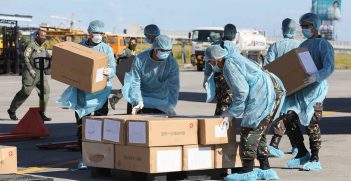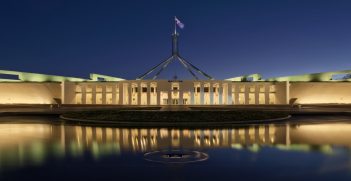Enter the Fourth Horseman: Coronavirus and Middle East States in Conflict

For nine years, the civil wars in Syria, Libya, and Yemen have caused massive casualty numbers, destruction, and refugee outflows, with hunger and economic collapse facing those who remain – three of the Four Horsemen of the Apocalypse. Now the pandemic is exacting an even greater toll.
This is the second of two reports on the impact of COVID-19 on the Middle East. The first was published on 17 July.
Remember the Arab Spring? When it emerged initially in Tunisia in late 2010, with popular demands for reform spreading across the Middle East, democratic change in a region long dominated by autocratic regimes seemed possible. That dream was brief. Though Egypt’s Hosni Mubarak and Tunisia’s Zine El Abidine Ben Ali left the scene, monarchs and generals reasserted their power with what was, in retrospect, surprising ease.
The three states whose rulers were unable to stare down the demonstrators – Syria, Libya, and Yemen – descended into civil wars which continue to rage. Now these countries are being hit by another catastrophe – the Coronavirus pandemic, which is forecast to far exceed the others in its devastating effects.
Syria
Though not formally concluded, the war is winding down. With help from Russia and Iran, Bashar al-Assad has effectively won. He now controls the entire country apart from the north-western province of Idlib. He is currently held back from a final offensive on Idlib by Russia, which with Iran provides vital military support to the regime. Russian President Vladimir Putin wants to maintain a working relationship with irascible Turkish ruler Recep Tayyip Erdogan, who is determined to prevent a further flow of refugees from Idlib into Turkey if the fighting resumes. It’s an unstable truce which could collapse at any time.
The war has caused untold human misery. Apart from deaths, which may number 500,000, some five million Syrians – of a pre-war population of around 18 million – have fled to neighbouring Lebanon, Turkey, and Jordan, where they live in crowded temporary camps with few basic facilities. Even more, an estimated seven million are internally displaced, living in often-damaged housing or collective shelters. The World Food Program estimates that 11.1 million Syrians require humanitarian assistance, with 9.3 million suffering food insecurity.
A growing economic crisis is exacerbating the humanitarian disaster, and is now affecting even pro-Assad Syrians who had thus far survived the war with their livelihoods reasonably intact. The reason is the collapse over the past six months of Lebanon’s banking system and economy. Before the civil war and throughout it, Syrians had used Lebanon as a reliable place to obtain dollars, vital for small businesses which had largely kept the economy afloat despite the conflict. Now they can’t, forcing Syrians to compete for scarce dollars in Syria and resulting in the precipitate fall of the Syrian currency. That has made all imports, including food and medicines, prohibitively expensive for average Syrians. As well, many Syrians lived off remittances from relatives working abroad – $1.6 billion a year, according to the World Bank – which Syrians accessed through the Lebanese banking system. No longer.
Now COVID-19 is subjecting Syrians across the country to another hammer blow. The number of reported infections and deaths is low – just 584 cases and 35 deaths as of 24 July. But this is believed to be a major underestimate, reflecting limited testing. Reports throughout the war indicated that the regime was targeting hospitals and health centres in rebel-held territory. More than half are reported to have been destroyed or ceased functioning, so the medical system can’t deal with large outbreaks of the virus. Though information on this latest crisis is scarce, what is clear is that the Assad regime has neither the strategy nor the resources to deal with it.
Libya
The current chaos in Libya results from misguided NATO intervention in 2011 that went beyond the UN Security Council “responsibility-to-protect” resolution that authorised it. The UK and France used the resolution to help the eastern rebel movement topple long-term leader Muammar Gaddafi. They then effectively abandoned the country, leaving it to its own devices.
The result was prolongation of the civil war that has split the country into three: the north-western region around the capital, Tripoli, ruled by the UN-recognised Government of National Accord (GNA); the rebel north-eastern region’s Tobruk administration, run by General Khalifa Haftar’s Libyan National Army; and the southern region, disputed by both sides, but largely controlled by local tribal leaders. The war is currently in a relatively quiet phase, following 14 months of conflict as the GNA beat back an assault by Haftar on Tripoli. But few doubt that fighting will resume elsewhere before long.
The pandemic has hit Libya when many health facilities across the country are inoperative due to deliberate targeting during the war. Libya claims to have 2,314 cases, with 56 deaths recorded as of 24 July in a population of nearly 7 million. But limited testing means that is bound to be an underestimate. Even before COVID-19, most hospitals did not have sufficient medication or personnel. Many medical professionals left the country during the years of violence.
The Libyan National Centre for Disease Control, located in Tripoli, is considered a neutral body. But it has struggled to coordinate an effective COVID-19 response across areas controlled by different warring factions in the west and east. Doctors are reported to be at risk of assault or death if they don’t prioritise local militants’ needs over those of the general population. Moreover, communities, municipalities, and militias regularly refuse to allow isolation wards to be established in their areas because of fears infection will spread from them.
Yemen
Even before the start of the civil war in 2011, Yemen was described as a failed state. The combination of overpopulation (at 29 million, Yemen is the second most populous state in the Arabian Peninsula), limited and depleting water resources, corrupt administration, and chronic tribal conflict made it dependent on international aid and remittances from Yemenis working abroad.
As a result of Arab Spring demonstrations in early 2011, long-time authoritarian president Ali Abdullah Saleh was forced to hand over power to his deputy, Abdrabbuh Mansour Hadi. But Hadi struggled with a separatist movement in the south, which enabled Al-Qaeda to establish itself there under the local title of AQ in the Arabian Peninsula. On top of this, the Houthi, a Zaidi Shia minority in the north supported by Iran, took advantage of Hadi’s weakness to declare independence, taking over the capital city of Sanaa in 2014.
Alarmed by the Houthi’s rise, which was seen as an Iranian attempt to establish a second front for anti-Saudi operations, Riyadh entered the war in early 2015 with a ruthless air campaign that failed to discriminate between military and civilian targets. More than 112,000 fatalities, including nearly 13,000 civilians, have been recorded.
On top of this, the UN has now warned that the death toll from COVID-19 “could exceed the combined toll of war, disease and hunger over the past five years.” The conflict has left millions of Yemenis without access to proper health care, clean water, or sanitation – crucial for preventing the virus from spreading. The reported number of cases is 1,654, with 461 deaths, as of 24 July. But with a reported testing rate of only 4 per million, those numbers are certainly vast underestimates.
Vital food, medical, and humanitarian supplies have been restricted by a land, sea, and air blockade Saudi Arabia has put in place. With no central government in charge, coordinating a response to the virus is almost impossible. Moreover, Yemen’s health system has been deliberately targeted by both sides during the fighting, leaving it incapable of coping with a pandemic.
The Fourth Horseman
In past nine years, Syria, Libya, and Yemen have experienced three of the Four Horsemen of the Apocalypse: War, Death, and Famine. They are now in the grip of the fourth – Pestilence. Their people have nowhere to hide and limited self-defences, and their leaders are focused on personal survival. This humanitarian disaster can only get worse.
Ian Parmeter worked for 37 years in the Department of Foreign Affairs and Trade), the Department of the Prime Minister and Cabinet, and the Office of National Assessments, He is currently a Research Scholar at the Centre for Arab and Islamic Studies, Australian National University. He can be contacted at ian.parmeter@anu.edu.au.
This article is published under a Creative Commons Licence and may be republished with attribution.





